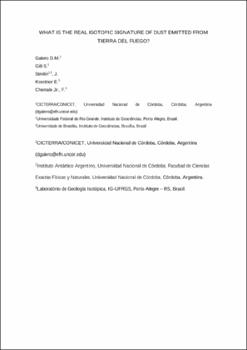| dc.contributor.author | Gaiero, D. M. | |
| dc.contributor.author | Gili, S. | |
| dc.contributor.author | Strelin, J. | |
| dc.contributor.author | Koestner, E. | |
| dc.contributor.author | Chemale Jr, F. | |
| dc.date.accessioned | 2024-04-16T12:04:13Z | |
| dc.date.available | 2024-04-16T12:04:13Z | |
| dc.date.issued | 2015 | |
| dc.identifier.uri | http://hdl.handle.net/11086/551431 | |
| dc.description.abstract | Sugden et al. (2009) suggested an on/off switch mechanism that could explain the 20 times increase of dust deposition in Antarctica during the Last Glacial Maximum (LGM), as compared to present day. This suggested switch resides in Patagonian pro-glacial lakes; when glaciers retreat sediments are deposited in the lakes and dust emission ceased in opposition to cold periods, when glacial pour out sediments to the outwash plain, then increasing dust emission. The on/off switch mechanism proposed is supported on age analyses and strontium (Sr) and neodymium (Nd) isotope ratios of ancient lacustrine sediment samples from the Magellan Strait (MS) and from the North Patagonian icefield (NPI). The lacustrine sediments were used as representative of sediments that were disgorged to the outwash plain during the LGM. We argue on the type of samples used to characterize the possible Patagonian outwash sediments deflated during the LGM and accordingly, on the interpretation of the source of this dust. Modern sediments are deflated from the Patagonian surface mainly from widespread ephemeral lakes (Gaiero 2007), which are sporadically refilled with sediments supplied from the surrounding areas mainly through water runoff. The aim of this contribution is to discuss about this and contrast data from both set of samples and discuss about their significance for the interpretation of the isotopic signatures recorded on the sedimentary archives of the Southern Hemisphere (e.g., Antarctic ice cores). Fig. 1 shows that the mean isotopic composition of dry lake sediments (collected from the ancient outwash plain in the San Sebastián Bay area) and dust collected at Río Grande are significantly different compared to MS samples and very similar to sediments representing the Fuegian continental shelf (Basile et al. 2007). Similar to modern dust released from continental Patagonia (north of ~52° S), modern data from Tierra del Fuego could also be explained by a mixing between Jurassic rhyolites and Quaternary volcanic rocks (e.g., Gaiero et al. 2007; Fig. 1). On the contrary, the samples used by Sugden et al. (2009) seem to characterize discrete sources. The isotopic composition of most samples from the MS plots mostly within the compositional field corresponding to the Antarctic Jurassic rhyolites and similar rocks that outcrop out close along the Fuegian Cordillera (Gaiero et al. 2007). In the case of NPI samples, their compositions are similar to the local outcropping Paleozoic plutonic and metasedimentary rocks (Killian and Behrmann 2003). Nevertheless, directly to the W of the NPI, the isotopic composition of Pliocene/Pleistocene Chilean trench sediments (mean 87Sr/86Sr = 0.707 and δNd(0) = -2.1) indicates a variable contribution from other rocks cropping out in the area (e.g., Quaternary volcanic rocks). Why MS and NPI samples are different from modern Patagonian dust? | es |
| dc.format.medium | Impreso | |
| dc.language.iso | eng | es |
| dc.rights | Attribution-NonCommercial-ShareAlike 4.0 International | * |
| dc.rights.uri | http://creativecommons.org/licenses/by-nc-sa/4.0/ | * |
| dc.subject | Ciencias de la Tierra | es |
| dc.subject | Geociencias | es |
| dc.subject | Geología isotópica | es |
| dc.subject | Antártica | es |
| dc.title | What is the real isotopic signature of dust emitted from Tierra del Fuego? | es |
| dc.type | conferenceObject | es |
| dc.description.fil | Fil: Gaiero, D.M. Consejo Nacional de Investigaciones Científicas y Técnicas. Centro de Investigaciones en Ciencias de la Tierra; Argentina. | es |
| dc.description.fil | Fil: Gili, S. Consejo Nacional de Investigaciones Científicas y Técnicas. Centro de Investigaciones en Ciencias de la Tierra; Argentina. | es |
| dc.description.fil | Fil: Strelin, J. Consejo Nacional de Investigaciones Científicas y Técnicas. Centro de Investigaciones en Ciencias de la Tierra; Argentina. | es |
| dc.description.fil | Fil: Strelin, J. Universidad Nacional de Córdoba. Facultad de Ciencias Exactas, Físicas y Naturales. Instituto Antártico Argentino; Argentina. | es |
| dc.description.fil | Fil: Koestner, E. IG-UFRGS. Laboratório de Geología Isotópica; Brasil. | es |
| dc.description.fil | Fil: Chemale Jr, F. IG-UFRGS. Laboratório de Geología Isotópica; Brasil. | es |
| dc.description.field | Geoquímica y Geofísica | |
| dc.conference.city | Ushuaia | |
| dc.conference.country | Argentina | |
| dc.conference.editorial | Editorial Utopias | |
| dc.conference.event | VI Congreso Argentino de Cuaternario y Geomorfologia | |
| dc.conference.eventcity | Ushuaia | |
| dc.conference.eventcountry | Argentina | |
| dc.conference.eventdate | 2015-4 | |
| dc.conference.institution | CADIC | |
| dc.conference.journal | VI Congreso Argentino de Cuaternario y Geomorfologia | |
| dc.conference.publication | Libro | |
| dc.conference.work | Resumen | |
| dc.conference.type | Congreso | |





